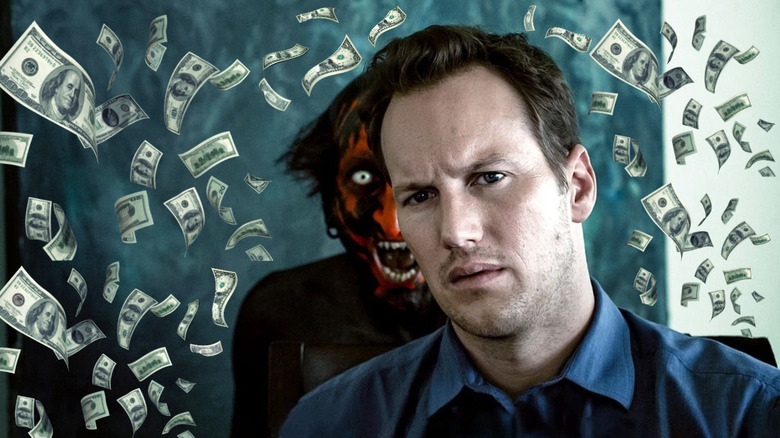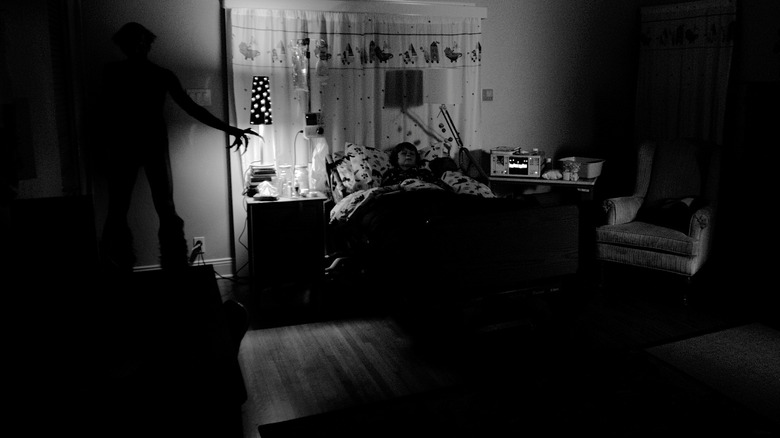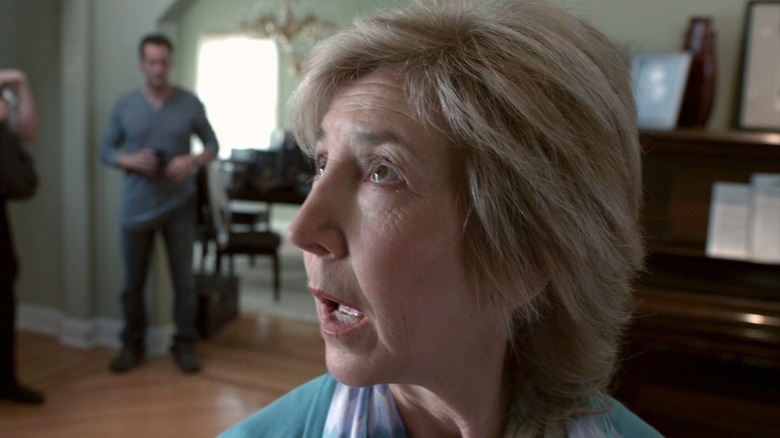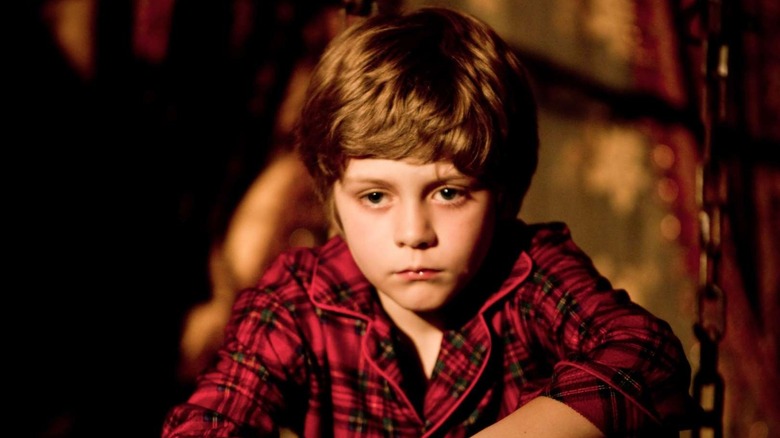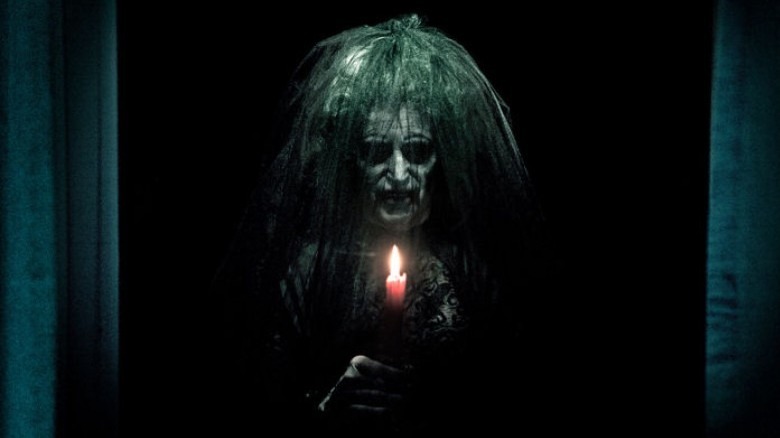Tales From The Box Office: Insidious Proved James Wan Was A Real Deal Horror Master
(Welcome to Tales from the Box Office, our column that examines box office miracles, disasters, and everything in between, as well as what we can learn from them.)
One could make the argument that no single director has had an impact on franchise filmmaking as big as James Wan has in the modern era. Yes, the man directed "Aquaman," the biggest DC movie ever, and "Furious 7," one of the 10 biggest movies of all time until pretty recently. But those were examples of him playing in someone else's sandbox with great success. Beyond that (and perhaps more importantly), Wan is a man who has demonstrated a miraculous ability to create something new, particularly within the horror genre. His defining moment came in 2011 with "Insidious."
Wan broke out in a big way in 2004 with "Saw," which was itself a huge hit and spawned a $1 billion franchise that is still going to this day. But one big hit can be a fluke, as evidenced by the filmmaker's 2007 sophomore effort, "Dead Silence." A movie with its fans, to be certain, but by no means a big hit. That's where "Insidious" comes in. The micro-budget film was a smash hit that, once again, birthed a new horror franchise that is going to this day. It proved that Wan's debut feature was not a fluke.
In honor of the release of "Insidious: The Red Door," we're looking back at the first film, how it came to be, how it managed to score a big distribution deal at Sony Pictures, what happened once the movie hit theaters, and what lessons we can learn from it more than a decade later. Let's dig in, shall we?
The movie: Insidious
The story of "Insidious" begins with revisiting the partnership that made "Saw" such a success. Wan reunited with that film's star and — more importantly — screenwriter Leigh Whannell to craft their version of a modern haunted house film. Taking inspiration from classics like "Poltergeist" while not looking to make a clone of such films, Whannell set about writing the script that Wan would end up directing.
"James and I came up with an idea that we felt we hadn't seen in horror films before which is this idea of astral projection," Whannell said in a making-of featurette for the film. "Looking at that idea, we thought the best place to house it would be a traditional haunted house film." In the same video, Wan also talked about "casting" the house, just as you would cast the actors in a film. In this case, that cast included Patrick Wilson ("Watchmen"), Rose Byrne ("Bridesmaids"), Lin Shaye ("Detroit Rock City"), and a young Ty Simpkins, who would eventually star in massive hits like "Iron Man 3" and "Jurassic World."
"I really wanted people to, at the beginning of the movie go, 'Well obviously it's a haunted house. Look how scary looking it is!'" Wan said. Whannell and Wan also had a pretty hard-and-fast rule about jump scares, as they felt such things were being overused in horror movies at the time.
"One of the commandments I had while writing the film was no false scares," Whannell said in the featurette. "I want my payoff to be real," Wan added. Not to get ahead of ourselves here, but that strategy worked. The film includes a number of effective scares, including an all-timer that quickly went down in the horror history books.
Making a scary movie, the PG-13 way
After the disappointment of "Dead Silence," Wan and Whannell wanted to have complete control over their next endeavor together. So, they kept the budget very small and produced "Insidious" outside of the studio system. Blumhouse Productions head Jason Blum was on board as a producer, as was "Paranormal Activity" director Oren Peli, so they were still in good company. But they would have very little to work with, as the budget ended up being just $1.5 million. Even adjusting for inflation, that's still next to nothing by Hollywood standards. Particularly for a movie that looks as good as this one does, it's worth pointing out.
But the bigger thing was that Wan didn't want to be known as the blood and guts guy, as the "Saw" sequels had really ratcheted things up in that department. Speaking with Entertainment Weekly in 2013, Wan explained that he didn't feel R-rated thrills are necessary to deliver a scary film.
"Part of the reason why I went off and made 'Insidious' [is] because I wanted to prove to people that I could make a very classic, old-fashioned haunted house film and show that I could make scary films without relying on blood and guts, which by the way the first 'Saw' movie had very little of compared to all the sequels, but people forget that."
Not to say that R-rated movies can't make a ton of money — just look at "Deadpool" — but getting a PG-13 rating certainly never hurt in that department. So, even though they didn't have a distributor during production, Wan seemingly was making the right decisions and setting the movie up for success. His artistic ambitions were well aligned with the makings of a commercial hit.
A successful screening leads to a big money deal
Once the film was in the can, the team set about getting it out on the festival circuit. It came to pass that "Insidious" would hold its premiere at the prestigious Toronto International Film Festival as part of the Midnight Madness program. As it turns out, things went extremely well, so much so that Wan and Whannell's film was able to secure a lot of interest from distributors in short order.
Very little was known about the film ahead of its release. The movie centers on parents (Wilson and Byrne) whose new home is haunted. Things get worse when their comatose son is possessed by a malevolent entity. Kept secret was the fact that the movie ventures into a demonic realm known as "The Further," which really helped to make it stand out, not to mention deliver the scares.
In the hours after the film's premiere screening, what was described as a "marathon bargaining session" broke out, with several suits offering up competing bids. Sony Pictures won out, offering up a seven-figure deal and a guaranteed theatrical release. This took place in September 2010. Ultimately, this would prove to be money very well spent for Sony, with the studio wasting very little time in getting Wan's haunted house flick in theaters for the moviegoing public to enjoy.
The financial journey
Rather than wait for the Halloween season, Sony decided to release "Insidious" in theaters in April. Again, the studio seemed to be well aware they had something special on hand. Instead, they opted to go for the counter-programming method, going up directly against the family-friendly flick "Hop" and Duncan Jones' sci-fi flick "Source Code," with all three debuting in theaters the weekend of April 1, 2011.
Of the new releases, "Insidious" placed third, taking in $13.2 million. But given the film's incredibly low production cost, even when accounting for Sony's acquisition price, that was a home run. Even in the face of competition such as "Hanna" and "Your Highness" the following weekend, word of mouth led to a mere 29.4 percent drop for the film, giving it a $9.3 million second weekend. Damn near unheard of in the horror genre, as those movies are prone to be frontloaded. Things continued to go extremely well, with the film earning $54 million domestically to go with $45.5 million overseas for a grand total of $99.5 million — a hair shy of the $100 million mark. Though not quite as impressive as "Paranormal Activity" making nearly $200 million with a budget well under $1 million, it's among the best budget-to-box-office ratios ever.
Two years later, Wan would return for "Insidious: Chapter 2," which would make even more money ($161.9 million, to be exact) against a still tiny $5 million budget. While the jury is still out on what "The Red Door" will do, the franchise has earned $555 million worldwide against combined budgets of just $26.5 million. That is downright astonishing. But that's what Wan is capable of when he's firing on all cylinders. He is rarely not firing on all cylinders — when left to his own devices.
The lessons contained within
Wan became bankable beyond reason in the aftermath of this success. He also directed "The Conjuring," which hit theaters in 2013 and generated an entire cinematic universe of horror films including spin-offs like "Annabelle." We're talking about a $2.1 billion franchise with much more on the way, including "The Nun 2" later this year. As a producer, Wan also does close to nothing but make hits, such as this year's "M3GAN," which is one of the biggest original hits of any kind since the pandemic. And yes, a sequel is on the way. Remarkably, another franchise to his credit.
Studios are, in the streaming era, going back to the well and bleeding everything dry over and over again. That's why Disney is already making a live-action version of "Moana," and why we're getting a ten-season "Harry Potter" TV show on the Max streaming service. Brand recognition is one of the best (and seemingly only) ways to cut through the noise in an age when thousands of movies and shows are available at the click of a button. It makes sense.
That said, the well will run dry eventually. It may seem odd to say this while the fifth "Insidious" movie is arriving in theaters, but creators absolutely must be given the latitude to bring original ideas to the widest audience possible now more than ever. These franchises we keep revisiting have to come from somewhere. Originality cannot be abandoned, and James Wan can't do it all himself, damn it. Risks must be taken for studios to enjoy the long-term rewards that come from a big franchise. Sure, there will be misses but the hits can sure as hell help to ease the sting. That's the business. That's the game.
And nobody plays that game better than Wan.
